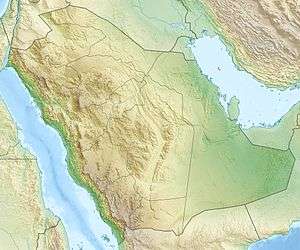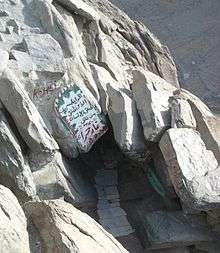Jabal al-Nour
| Jabal an-Nour | |
|---|---|
|
Jabal al-Nour in Mecca. | |
| Highest point | |
| Elevation | 642 m (2,106 ft) |
| Coordinates | 21°27′29″N 39°51′41″E / 21.45806°N 39.86139°ECoordinates: 21°27′29″N 39°51′41″E / 21.45806°N 39.86139°E |
| Geography | |
 Jabal al-Nour Location of Jabal al-Nour in Saudi Arabia | |
| Location | Mecca, Saudi Arabia |
Jabal an-Nour (also Jabal an-Nur or Jabal Nur), also translated from Arabic جبل النور as "The Mountain of Light" or "Hill of Illumination", is a mountain near Mecca in Saudi Arabia's Hejaz region.[1] It is one of the most popular tourist attractions in Mecca. The mountain houses the famed Ghar Hira or Hira cave. The cave is quite small, four arm's length long by 1.75 arm's length wide.[2] The mountain is barely 640 m tall. It does however, take two hours to make it to the cave and is extremely strenuous on the individual. However, the mount and the cave hold tremendous significance for Muslims throughout the world. The Islamic prophet Muhammad is said to have spent a great deal of time in the cave meditating and it is believed that he had received his first revelation from the archangel Gabriel, inside this cave from Allah.
Naming

Since this is where Muhammad is said to have received the first verses of the Quran, the mountain was given the title "Jabal-al-Nour". "Jabal" in Arabic means mountain and "Nour" or "Noor" means light or enlightenment. This experience is sometimes identified with the beginning of revelation; hence the present name.[3] As for the exact date of the first revelation it can be seen through investigation to fix the time to Monday the 21st of Ramadan at night, i.e. August, 10, 610 C.E. or exactly 40 lunar years, 6 months and 12 days of age i.e., 39 Gregorian years, 3 months and 22 days.[4] ..
Significance
Before Muhammad’s first revelation, he was said to have pleasant dreams. Among these dreams were signs that his Prophethood was starting to appear, and signs that the stones in Mecca would greet him with Salaam which is believed to have been proved true. These dreams lasted for six months.[5] An increasing need for solitude led Mohammed to seek seclusion and meditation in the rocky hills which surrounded Mecca.[6] There he would retreat to Hira Cave for one month,[7][8] each year, engaging in tahannuth,[9] which means self-justification for the purpose of the Quraysh to engage during Jahiliyyah.[10][11] He would take provisions along with him during this retreat, and would feed the poor that would come to him. Then before returning home to his family for more provisions he would circumambulate the Kaaba seven times, or however many times Allah willed; then he would go home.[12]
Appearance
One physical feature that differentiates Jabal al-Nour from other mountains and hills is its strange-looking summit, which makes it look more like two mountains on top of each other. The top of this mountain in the mountainous desert is one of the loneliest of places. However, the cave within, which faces the direction of the Kaaba, is even more isolated. While standing in the courtyard back then, people could only look over the surrounding rocks. Nowadays, people can see the surrounding rocks as well as buildings that are hundreds of meters below and hundreds of meters to many kilometers away. Hira is both without water or vegetation other than a few thorns. Hira is higher than Thabir, and is crowned by a steep and slippery peak, which Muhammad with some companions once climbed. Muhammad was in the habit of staying here with his wife.[13]
See also
References
- ↑ "Jabal al-Nour (The Mountain Of Light) and Ghar Hira (Cave of Hira)". 16 September 2015.
- ↑ Mubārakfūrī, Ṣafī -R. Ar-Raheeq Al-Mak̲h̲tūm = The Sealed Nectar: biography of the noble prophet. Riyadh, Saudi Arabia, 2002. Print.
- ↑ Weir, T.H.; Watt, W. Montgomery. "Ḥirāʾ." Encyclopaedia of Islam, Second Edition. Edited by: P. Bearman, Th. Bianquis, C.E. Bosworth, E. van Donzel, W.P. Heinrichs. Brill Online, 2013. Reference. Augustana College. 07 October 2013 <http://referenceworks.brillonline.com/entries/encyclopaedia-of-islam-2/hira-SIM_2890
- ↑ Mubārakfūrī, Ṣafī -R. When the Moon Split: a biography of Prophet Muhammad. Riyadh. 1998.
- ↑ Mubārakfūrī, Ṣafī -R. When the Moon Split: a biography of Prophet Muhammad. Riyadh. 1998.
- ↑ Peterson, Daniel C. Muhammad, prophet of Allah. Grand Rapids, Mich. 2013.
- ↑ Weir, T.H.; Watt, W. Montgomery. "Ḥirāʾ." Encyclopaedia of Islam, Second Edition. Edited by: P. Bearman, Th. Bianquis, C.E. Bosworth, E. van Donzel, W.P. Heinrichs. Brill Online, 2013. Reference. Augustana College. 07 October 2013 <http://referenceworks.brillonline.com/entries/encyclopaedia-of-islam-2/hira-SIM_2890>
- ↑ al-Tabarī, Abū Ja'far Muhammad B. Jarīr, W. Montgomery Watt, and M. V. McDonald. 1988. The history of al-Tabarī = Ta'rīkh al-rusul wa'l-mulūk. Vol. 6, Vol. 6. Albany, N.Y.: State University of New York Press.
- ↑ Weir, T.H.; Watt, W. Montgomery. "Ḥirāʾ." Encyclopaedia of Islam, Second Edition. Edited by: P. Bearman, Th. Bianquis, C.E. Bosworth, E. van Donzel, W.P. Heinrichs. Brill Online, 2013. Reference. Augustana College. 7 October 2013 <http://referenceworks.brillonline.com/entries/encyclopaedia-of-islam-2/hira-SIM_2890>
- ↑ al-Tabarī, Abū Ja'far Muhammad B. Jarīr, W. Montgomery Watt, and M. V. McDonald. 1988. The history of al-Tabarī = Ta'rīkh al-rusul wa'l-mulūk. Vol. 6, Vol. 6. Albany, N.Y.: State University of New York Press.
- ↑ Weir, T.H.; Watt, W. Montgomery. "Ḥirāʾ." Encyclopaedia of Islam, Second Edition. Edited by: P. Bearman, Th. Bianquis, C.E. Bosworth, E. van Donzel, W.P. Heinrichs. Brill Online, 2013. Reference. Augustana College. 07 October 2013 <http://referenceworks.brillonline.com/entries/encyclopaedia-of-islam-2/hira-SIM_2890>
- ↑ al-Tabarī, Abū Ja'far Muhammad B. Jarīr, W. Montgomery Watt, and M. V. McDonald. 1988. The history of al-Tabarī = Ta'rīkh al-rusul wa'l-mulūk. Vol. 6, Vol. 6. Albany, N.Y.: State University of New York Press.>
- ↑ Weir, T. H.. "Ḥirāʾ." Encyclopaedia of Islam, First Edition (1913-1936). Edited by M. Th. Houtsma, T.W. Arnold, R. Basset, R. Hartmann. Brill Online, 2013. Reference. Augustana College. 07 October 2013 <http://referenceworks.brillonline.com/entries/encyclopaedia-of-islam-1/hira-SIM_2820>